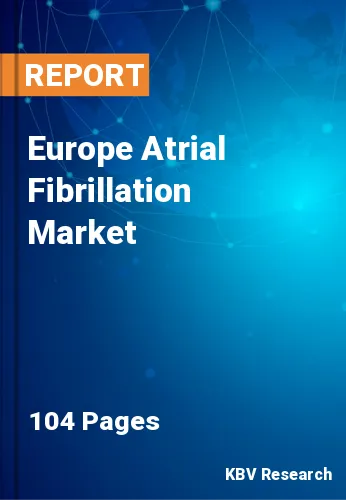The Europe Atrial Fibrillation Market would witness market growth of 5.4% CAGR during the forecast period (2022-2028).
Medications to lower heart rate to a range close to normal (rate control) or change the rhythm to normal sinus rhythm are frequently used to treat AF (known as rhythm control). If a person is unstable, electrical cardioversion, which can return AF to a normal heart rhythm, is frequently required. Some people's recurrences may be prevented with ablation. Blood-thinning medications are not always necessary for people with AF who have a low risk of stroke, however, some medical professionals may recommend aspirin or an anti-clotting drug.
Experts often advise using an anti-clotting medicine for people at higher than low risk. Warfarin and other direct oral anticoagulants are examples of anticoagulant medicines. The majority of persons have an increased risk of stroke. These drugs lower the risk of stroke but raise the incidence of serious bleeding. Heart-rate-related symptoms are frequently seen with AF. Palpitations, exercise intolerance, and occasionally anginal difficulty breathing can all be symptoms of rapid and irregular heart rates.
Rapid and irregular heart rates can also cause the heart to beat too quickly, irregularly, or skip beats. Congestive heart failure symptoms including exhaustion, breathlessness, or edema are further potential signs. Sometimes the abnormal heart rhythm (arrhythmia) is only discovered after a stroke or transient ischemic attack first occurs (TIA). Because AF frequently doesn't generate symptoms, it is fairly unusual for someone to learn they have it via a normal physical examination or EKG.
Cardiovascular disorders are the main cause of mortality. They encompass a wide range of medical conditions that affect the vascular system (the heart and blood vessels), frequently as a result of atherosclerosis, the abnormal build-up of plaque on the inner walls of an individual's arteries that is made up, among other things, of cholesterol or fatty substances. The several EU Member States have seen a decline in the number of fatalities brought on by circulatory system disorders in recent years. Increased screening, new surgical techniques, the use of new medications, and changes in patients' lifestyles might all have contributed to these developments, at least in part (for example, a reduction in the number of smokers).
The Germany market dominated the Europe Atrial Fibrillation Market by Country in 2021; thereby, achieving a market value of $174.8 million by 2028. The UK market would exhibit a CAGR of 4.5% during (2022 - 2028). Additionally, The France market is anticipated to grow at a CAGR of 6.2% during (2022 - 2028).
Based on End User, the market is segmented into Hospitals, Specialty Clinics, and Others. Based on Type, the market is segmented into Surgical and Non-Surgical. Based on Technology, the market is segmented into Radiofrequency, Laser, Cryotherapy, and Others. Based on countries, the market is segmented into Germany, UK, France, Russia, Spain, Italy, and Rest of Europe.
Free Valuable Insights: The Global Atrial Fibrillation Market will Hit $2.7 Billion by 2028, at a CAGR of 9.5%
The market research report covers the analysis of key stake holders of the market. Key companies profiled in the report include Johnson & Johnson, MicroPort Scientific Corporation, Boston Scientific Corporation, Abbott Laboratories, Medtronic PLC, BIOTRONIK SE & Co. KG, Koninklijke Philips N.V., Siemens Healthineers AG (Siemens AG) and AtriCure, Inc.
By End User
By Type
By Technology
By Country
Our team of dedicated experts can provide you with attractive expansion opportunities for your business.

